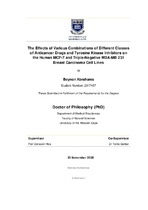| dc.contributor.advisor | Hiss, Donavon | |
| dc.contributor.advisor | Gerber, Tonie | |
| dc.contributor.author | Abrahams, Beynon | |
| dc.date.accessioned | 2021-02-24T12:33:04Z | |
| dc.date.available | 2022-02-24T22:10:03Z | |
| dc.date.issued | 2020 | |
| dc.identifier.uri | http://hdl.handle.net/11394/7881 | |
| dc.description | Philosophiae Doctor - PhD | en_US |
| dc.description.abstract | Globally, breast cancer is the most common cancer affecting women and it is predicted that in 2030 about 12 million deaths will occur with approximately 21.7 million new cases [2]. Genetic risk factors as well as race and ethnicity, account for about 5-10% of all breast cancer occurrences. Triple negative breast cancer (TNBC), tumors that tested negative for oestrogen receptor (ER), progesterone receptor (PR) and human epidermal growth factor receptor 2 (HER2), contribute to 10-20% of all breast carcinomas [3,4] and is known to be a more aggressive type of cancer with varying degree of response to chemotherapeutic and radiation therapy [5,6] | en_US |
| dc.language.iso | en | en_US |
| dc.publisher | University of the Western Cape | en_US |
| dc.subject | Breast cancer | en_US |
| dc.subject | MCF-7 breast carcinoma cells | en_US |
| dc.subject | MDA-MB-231 TNBC cells | en_US |
| dc.subject | Tyrosine kinase inhibitor | en_US |
| dc.subject | EGFR inhibitor | en_US |
| dc.title | The effects of various combinations of different Cdasses of anticancer drugs and tyrosine kinase inhibitors on the human MCF-7 and triple-negative MDA-MB 231 breast carcinoma cell lines | en_US |
| dc.rights.holder | University of the Western Cape | en_US |

